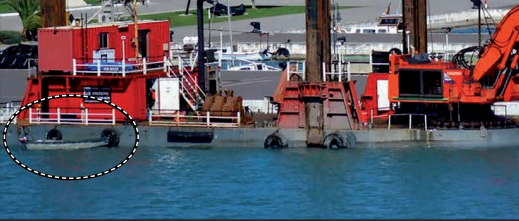The UK MAIB has issued latest Safety Digest to draw the attention to lessons learned from maritime accidents.This latest edition of the Safety Digest contains 25 articles which are examples of poor risk awareness demonstrated by the crews of vessels. The publication once again highlights that a cautionary approach should be second nature to every mariner about to start a task or embark on a course of action on the bridge, in the engine room or on deck.One case refers to an accident in which two crewmen went ashore from their anchored workboat in a borrowed open dinghy.
It was a hot summer’s day in the Mediterranean and the crewmen thought that it was a good opportunity to stretch their legs and get some provisions. The short passage to the nearby marina, which was less than a mile away, passed without incident and the crewmen spent the next few hours in the town. They had a couple of beers and wines in local bars and bought a trolley full of provisions from a supermarket. The crewmen loaded the provisions into the dinghy and returned the trolley back to the supermarket. However, by the time they were ready to leave the wind had picked up and the sea outside the marina was noticeably choppy. Consequently, the crewmen decided to wait in the marina bar until the conditions improved.
About an hour later, the crewmen decided it would be alright to return to the workboat.They were hungry and had no means of communicating with the two crewmen who
had remained on board. The waters inside the marina were protected by a breakwater and the crewmen had no difficulty navigating towards the marina entrance. However, as soon as the open dinghy rounded the breakwater and headed towards the open sea, waves started to come over the gunnels. To reduce the water ingress, the dinghy was slowed and its heading was adjusted. However, when the dinghy was turned again into sea about 100m from the workboat, it was quickly overwhelmed in the choppy seas. The dinghy flooded rapidly and started to submerge. The crew remaining on board the workboat saw what had happened and quickly collected two lifejackets, a life-ring and line. One of the crew then climbed into the life-ring, jumped into the sea with the two lifejackets and swam towards the men in the water. Unfortunately, one of the men in the water had lost consciousness and could not be revived.
Lessons learned
1. The operating limits of small open boats can be easily exceeded when used in open and exposed waterways. Although conditions might look good when setting off, they can change for the worse very quickly. Don’t take chances. Know the limitations of small boats and tenders, and carefully plan all trips taking into account the potential effects of changing weather, tide and visibility. Where necessary, delay, postpone or cancel.
2. It is always safer to wear a lifejacket when travelling in an open boat than not to. The effects of shock, injury or lack of fitnesshave the potential to reduce a person’s chances of survival no matter how good a swimmer they are, how warm or calm the water is or how close they are to the shore. Lifejackets might not be a fashion accessory when going ashore – but they are not meant to be.
3. It does not take a lot of alcohol to impair judgment or make a person more likely to take risks. This is worth remembering when there is work to be done and lives are at stake. One drink can hurt.
Source & Image Credit: UK MAIB Safety Digest 2016/01






























































